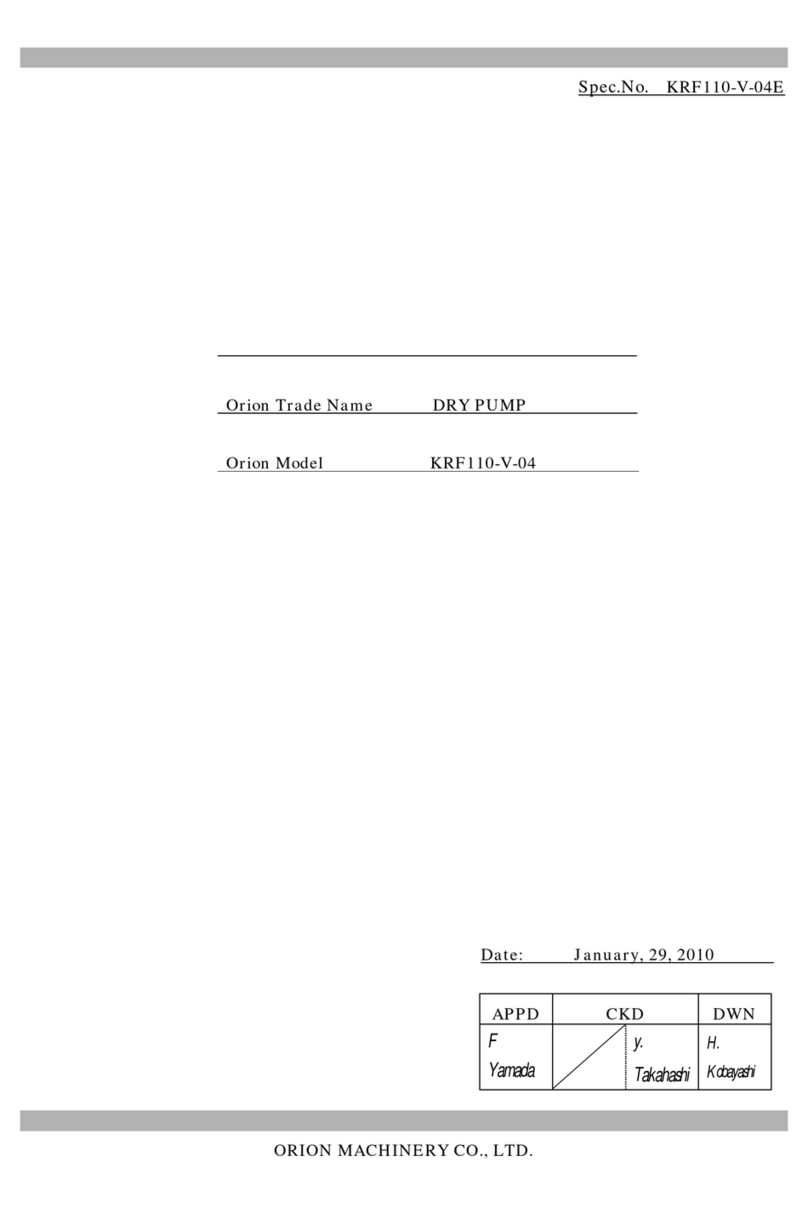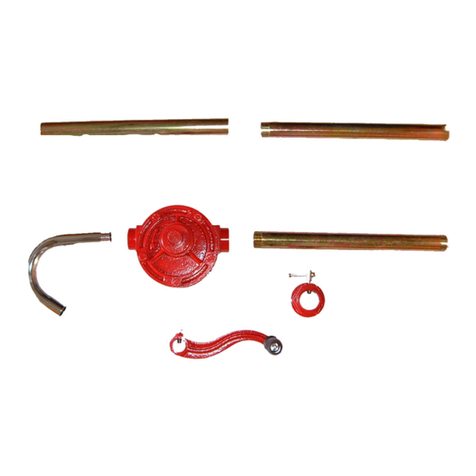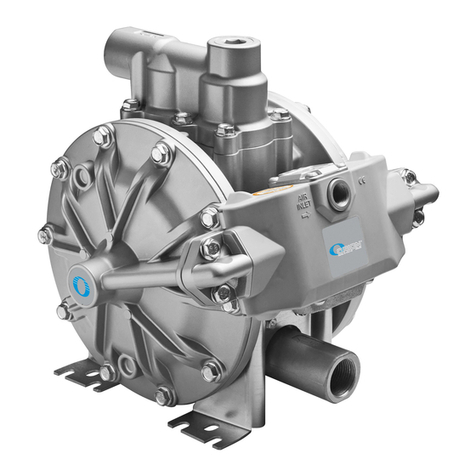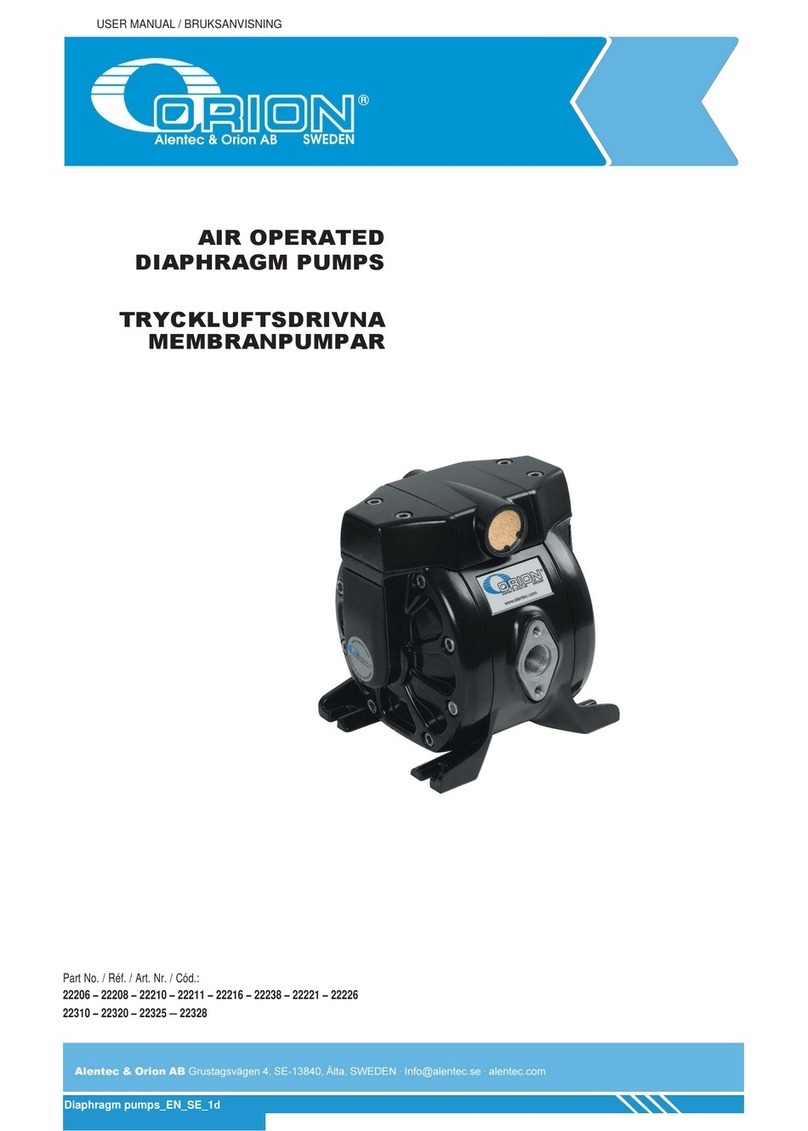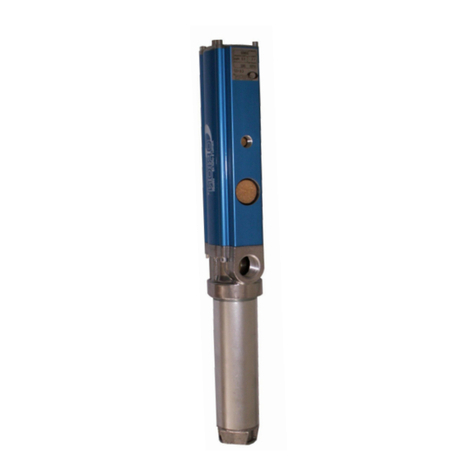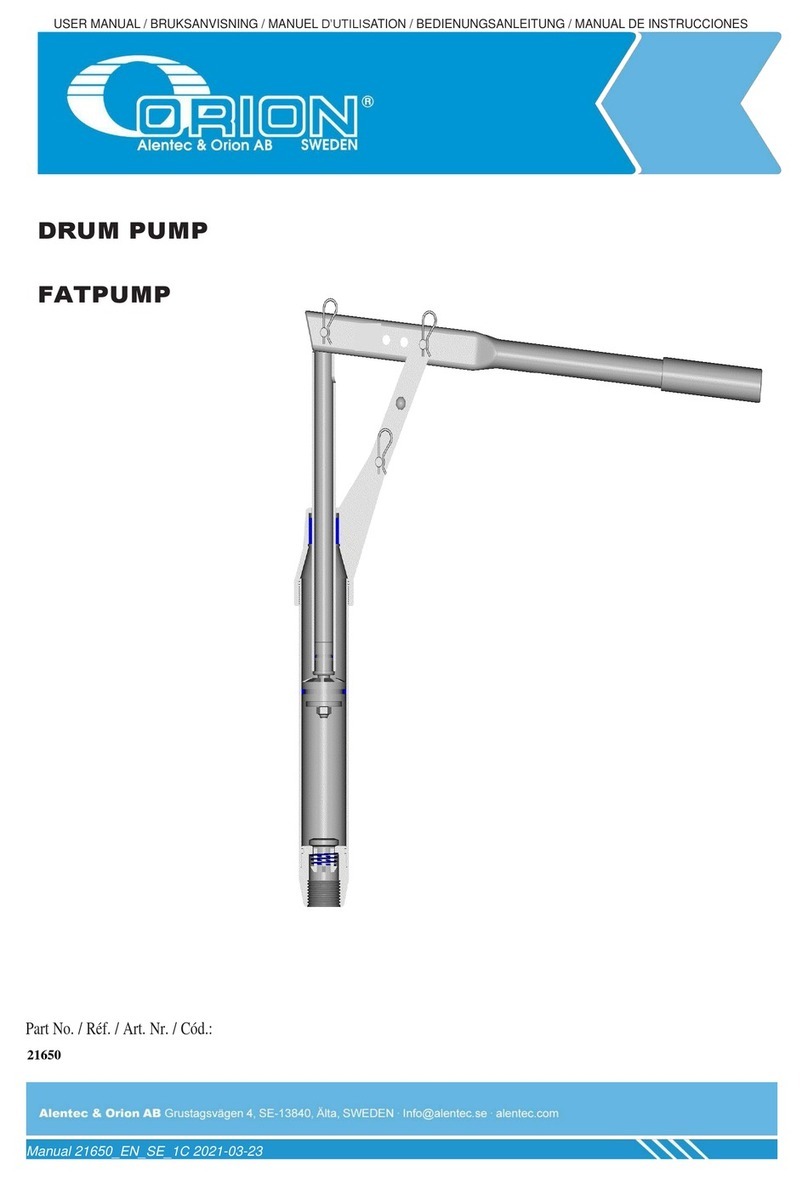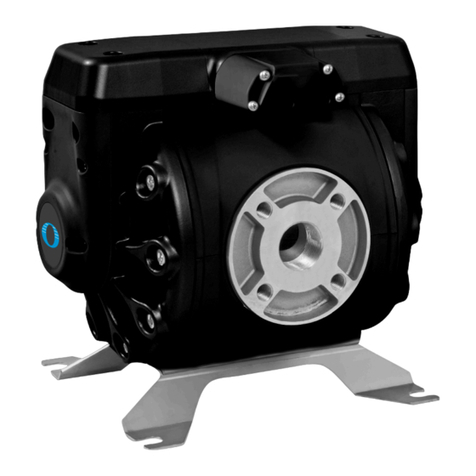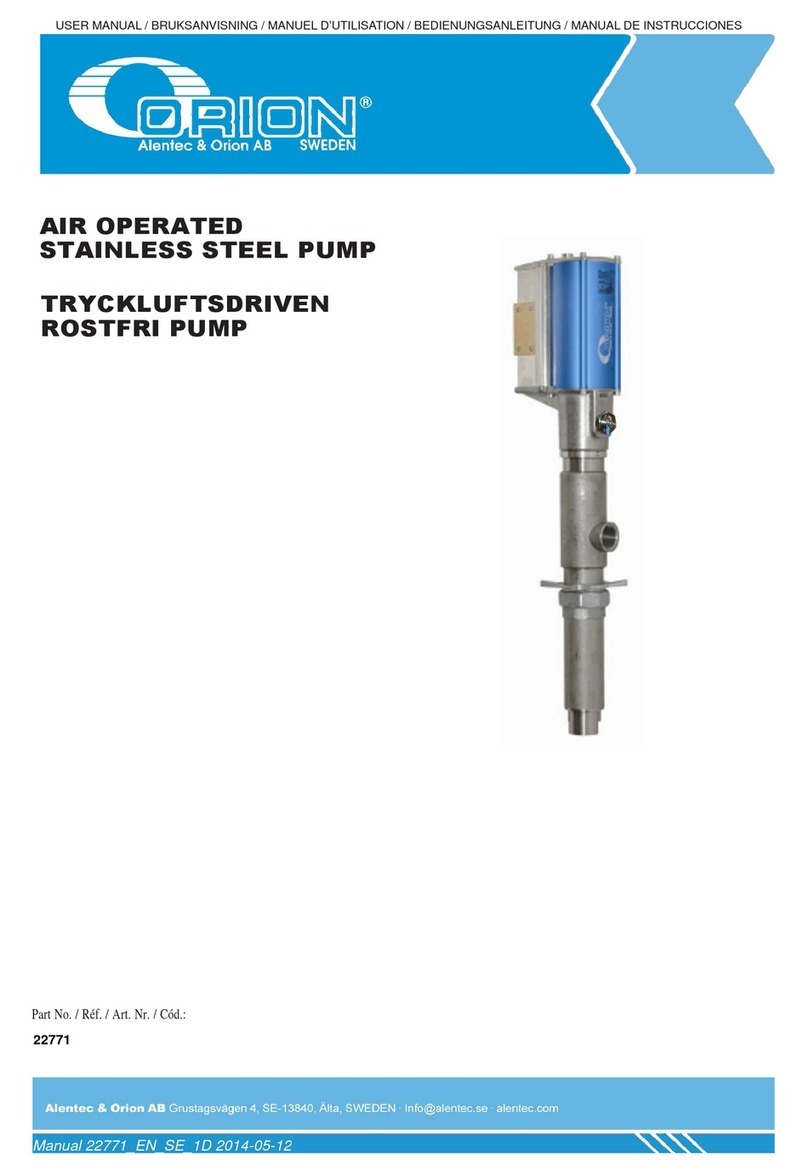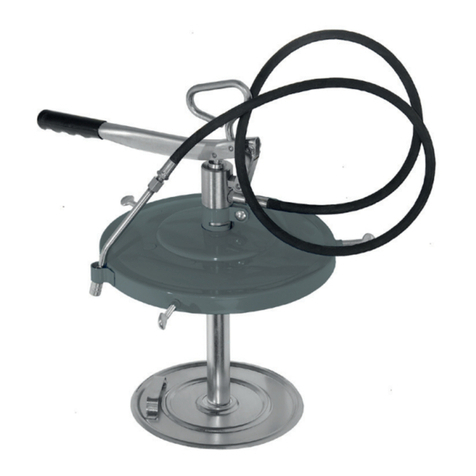
Alentec
&
Orion
AB
Grustagsvägen 4, SE-13840, Älta, SWEDEN · [email protected] · www.alentec.com3
INSTALLATION
are suitable for the working pressure of the system. Do not exceed the
maximum air pressure of the pump. The system must be tested to 1.3 times
the working pressure before being put into operation. NOTE! Remove all
hoses or other components which are not allowed to be exposed for that
high pressure. All test results must be kept and led together with this
manual. Close and disconnect the air supply and relieve the liquid pressure
in the system before any work to the pump or the system is carried out. Only
use genuine manufacturers spare parts. Never use any worn or damaged
spare parts. Avoid holding directly on the high pressurized outlet hose.
The high pressure hose can be protected by a separately PVC-hose being
slipped over it. Do not direct outlet valves or any other dispensing valve
against the body or any other person as the grease can penetrate the skin
or damage the eyes. Periodically inspect all system components for leakage
or damage, especially the hoses which can be worn out due to wear and
age. Rectify any defects immediately. Always turn off the air pressure to the
pump when the premises are unattended.
INSTALLATION
Mobile Units
Remove the protective packing from the pump including plugs in the air
inlet and the grease outlet. Remove the drum adaptor from the pump tube.
Mount the adapter into the 2” hole in the drum or pump bracket. Put the
pump vertically into the drum and lock the pump so that the outlet comes
into the desired position. Set the pump 10-15 mm clear of the bottom of the
drum and lock the pump with the adapter. Connect the grease outlet hose
into the outlet of the pump (3/8”BSP f). Mount the air quick coupling nipple
into the air inlet (¼”BSP f) on top of the pump. Important! If the air pressure
in the system is higher than the working pressure of the pump it will be
necessary to install an air regulator with gauge into the airline prior to the
pump. A shut-off valve should always be installed into the airline between
the air connection hose and the air pipe work. The pump is pre-lubricated
with Silicon grease. It is not necessary to use a lubricator under normal
operating conditions. Important! If a lubricator has been used with the pump
it is necessary to continue using it. This is because the oil from the lubricator
will have washed the silicon grease away. If the lubricator is not continuous-
ly used could that result in the pump damage.
Fixed installations
Besides the above mentioned, please also note the following. The pipe work
must be installed according to local regulations for this type of equipment.
Do not mount a pump directly onto a sheet metal wall or similar construc-
tion, which can create noise resonance and augment the normal noise level
of the pump. A hose must be installed between the pump and the piping. It
must have enough length to make it possible to lift the pump in and out of
the drum or tank without difculty. A shut-off valve must always be installed
at the beginning of the pipe work to make service easier and to make it
possible to cut off the ow of liquid when necessary. At each branch and
before each hose reel outlet a shut-off valve should be installed. The shut off
valve should have the same pressure rating as the corresponding working
pressure of the system. When starting up the system for the rst time, all
valves should be opened to bleed air from the system. Air pockets in pipe
work create a “spring” effect, which sometimes prevents the pump from
reaching stall pressure. It may be necessary to bleed the system at a high
point to release any air pockets. Do not let the pump run fast when starting
up a new system or changing barrels in an existing system. Start the pump
by lowering the air pressure on initial priming and increase the air pressure
Kontrollerar att alla anslutna komponenter är avsedda och lämpade för
systemets arbetstryck. Använd inte högre lufttryck än det som behövs för att
uppnå lämplig systemfunktion. Provtryck eventuella rörledningar med 1,3 x
systemets arbetstryck innan de tas i drift. Ta dock först bort ev. slanglednin-
gar och komponenter som ej får belastas med detta provtryck. Provtrycknin-
gen ska dokumenteras och sparas tillsammans med denna bruksanvisning.
Stäng av lufttillförseln och avlasta fettledningen innan något arbete på
pumpen eller systemet påbörjas. Använd alltid originaldelar. Återmontera
aldrig en skadad eller sliten detalj. Undvik att hålla direkt i högtrycksslangen.
(Högtrycksslang på matarventil kan skyddas genom att en PVC-slang träs
över den). Rikta aldrig ventilens eller andra distributionsenheters munstyc-
ken mot kroppsdel eller någon annan person. En tunn stråle av fettet/väts-
kan tränger lätt igenom huden eller kan skada ögonen. Kontrollera regelbun-
det alla komponenter med avseende på läckage och ev. skador överkörning,
brytning etc. Särskilt slangledningar är utsatta för nötning. Stäng alltid av
eller koppla bort tryckluften till pumpen över natten och vid driftsuppehåll.
INSTALLATION
Mobila enheter
Tag bort skyddsemballage och skyddspluggar från pumpmotor, pumprör
och utloppshus. Det sitter en gummihylsa över bottenventilen. Den måste
tas bort innan pumpen monteras i fatet. Lossa fatadaptern på pumpröret så
att den lätt kan skruvas i centrumhålet i fatlocket. Pumpen kan användas
för alla självsjunkande fetter; ev. måste följelock användas. För att undvika
kraterbildning formas fettet till en kon och en för fettet lämplig olja fylls i en
ring runt fatkanten. Sätt ner pumpen i fatet och fäst locket i fatkanten. Ställ
in pumprörsnivån så att det blir ca 10-15 mm spel mot fatets botten och lås
därefter fast pumpen med fatadaptern. Anslut utloppsslangen mot pumpens
utlopp (G3/8”inv.). Montera luftsnabbkopplingen i luftanslutningen (G1/4”
inv.) på pumpens ovansida. Viktigt! Om tryckluftledningen har högre tryck än
det som pumpen ska användas för måste en tryckluftsregulator med mano-
meter monteras före pumpen. En avstängningsventil ska alltid monteras på
uttagsstället för tryckluft. Den monteras före ev. lter/regulator. Pumpen är
initialsmord med Silikon-fett. Den behöver ej någon tillsatssmörjning under
normala driftsförhållanden. Viktigt! Om det nns en monterad luftsmörjare
och denna är eller har varit inkopplad mot pumpen måste man fortsätta
med att alltid ha luftsmörjare inkopplad. Detta för att oljan från luftsmörja-
ren tvättar bort silikonfettet. Slutar man med tilläggssmörjningen får man
slitageskador i luftmotorn.
Stationära anläggningar
Utöver det föregående gäller även följande Rörledningssystemet ska utföras
med iakttagande av de rörledningsbestämmelser och normer som myndi-
gheterna har beslutat ska gälla för denna typ av utrustning. Montera aldrig
en pump direkt på en plåtvägg, eller annan liknande konstruktion som kan
ge resonansljud och förstärka pumpens normala ljudnivå. En slangledning
ska monteras mellan pumpens utloppsanslutning och rörledningen. Den ska
ha en längd som gör det möjligt att utan besvär lyfta pumpen i och ur fatet.
En avstängningsventil ska alltid monteras i början av rörledningen för att un-
derlätta vid service och för möjlighet att stänga av ödet vid behov. Vid varje
förgrening och före varje slangrulle/uttagsställe ska en avstängningsventil
monteras. Den ska ha en tryckklass som motsvarar maximalt arbetstryck
i systemet. När systemet startas för första gången skall alla ventiler vara
öppna för att tillåta att luften i rören kan evakueras. Eventuella kvarvarande
luftckor kan genom sin sk. fjädereffekt orsaka att pumpen inte stannar när
max.trycket uppnåtts. Det kan ibland var nödvändigt att lufta rörledningen
